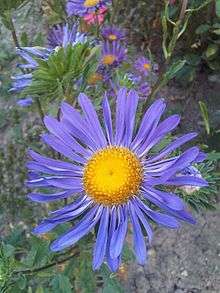Callistephus
| Callistephus | |
|---|---|
 | |
| Callistephus chinensis | |
| Scientific classification | |
| Kingdom: | Plantae |
| (unranked): | Angiosperms |
| (unranked): | Eudicots |
| (unranked): | Asterids |
| Order: | Asterales |
| Family: | Asteraceae |
| Tribe: | Astereae[1] |
| Genus: | Callistephus Cass. |
| Species: | C. chinensis |
| Binomial name | |
| Callistephus chinensis (L.) Nees | |
| Synonyms[2] | |
| |
Callistephus /kæˈlɪstᵻfəs/[3] is a monotypic genus of flowering plants in the aster family, Asteraceae, containing the single species Callistephus chinensis. Its common names include China aster and annual aster.[4][5] It is native to China and Korea.[4][6] and it is cultivated worldwide as an ornamental plant.[2][7]
This is an annual or biennial herb with one erect, mostly unbranched stem growing 20 to 100 centimeters tall. The alternately arranged leaves vary in shape or size. The basal leaves usually fall away be flowering. Leaves around the middle of the stem are a few centimeters long and are borne on winged petioles. The blades have serrated edges. Leaves toward the top may have smooth edges. The large solitary flower head grows at the top of the stem and sometimes on branches. The head is lined with layers of phyllaries, those in the outer layer large and leaflike, measuring up to 3 centimeters long. The inner layer can be purple-tinged. The head contains one or two rings of ray florets, most often in shades of reddish purple. Cultivated varieties can have ray florets in most any color, including red, pink, blue, purple, and white. They are up to 3.5 centimeters long. There are many yellow disc florets in the center. The fruit is a rough-textured, glandular, purple-mottled cypsela that turns gray with age. It has a pappus composed of one outer layer of reddish scales and two inner layers of white bristles.[7]
This plant is a naturalized species in some areas outside of its native range (Indochina, Europe, North America, Australia, New Zealand, etc.).[2][4]
This species has been grown and bred extensively in cultivation. Cultivars are available with flowers of many colors, varying heights, and single and double heads.[6] The plants are susceptible to fusarium wilt, a fungal disease. Some cultivars are more resistant to this than others. Pest insects can include leafhoppers, aphids, blister beetles, and the tarnished plant bug. The plant is also susceptible to mites.[5]
Gallery
- In pink
.jpg) In lilac
In lilac In yellow
In yellow.jpg) Aster de Chine (1833) by Pierre-Joseph Redouté
Aster de Chine (1833) by Pierre-Joseph Redouté.jpg) On a 1970 USSR postage stamp
On a 1970 USSR postage stamp
References
| Wikimedia Commons has media related to Callistephus. |
- ↑ Nesom, G. L. (1994). Subtribal classification of the Astereae (Asteraceae). Phytologia 76, 193–274. Cited in: Noyes, R. D. and L. H. Rieseberg (1999). ITS sequence data support a single origin for North American Astereae (Asteraceae) and reflect deep geographic divisions in Aster s. l. American Journal of Botany 86, 398–412.
- 1 2 3 Flann, C (ed) 2009+ Global Compositae Checklist
- ↑ Sunset Western Garden Book, 1995:606–607
- 1 2 3 Callistephus chinensis. Germplasm Resources Information Network (GRIN).
- 1 2 Gilman, E. F. and T. Howe. Callistephus chinensis. Fact Sheet FPS-94. University of Florida IFAS. 1999.
- 1 2 Callistephus chinensis. Missouri Botanical Garden.
- 1 2 Callistephus chinensis. Flora of China.